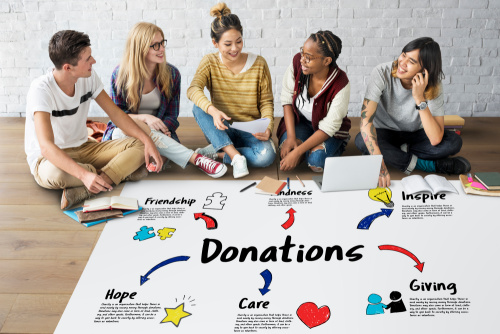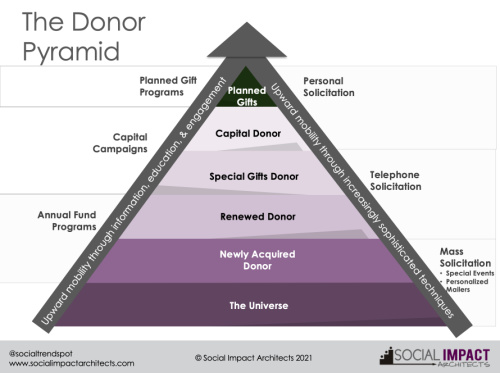 Americans have always been generous. But, as in other trying times, 9/11 or the Great Recession, Americans stepped up their giving. Indiana University’s Women’s Philanthropy Institute released a report that 56% of U.S. households engaged in charitable giving during the pandemic. In 2020, Americans gave roughly $471.44 billion to U.S. charities in 2020, which was a 5.1% increase (or 3.8% adjusted for inflation) from giving in 2019. This level of giving is a remarkable response to a challenging year.
Americans have always been generous. But, as in other trying times, 9/11 or the Great Recession, Americans stepped up their giving. Indiana University’s Women’s Philanthropy Institute released a report that 56% of U.S. households engaged in charitable giving during the pandemic. In 2020, Americans gave roughly $471.44 billion to U.S. charities in 2020, which was a 5.1% increase (or 3.8% adjusted for inflation) from giving in 2019. This level of giving is a remarkable response to a challenging year.
Each year since 1956, the sector anxiously awaits the results of the Giving USA Report. This annual report looks at the past year and releases key data and trends. In partnership with fundraising expert, Tawnia Wise, CFRE, CEO of Wise Resource Development, we are sharing our annual update as well as some thoughts and ideas on today’s giving trends and what the future may hold.
The good news is that almost all issues areas did well – the chart below summarizes the changes in 2020. This level of giving not only outpaced our projections, but it also signifies the highest level of charitable giving on record. Marked increases in giving were directed toward international affairs, public society and human services agencies. Gifts were diverted away from arts, culture and humanities organizations, which saw the greatest decline in giving (going from a 11.3% increase in 2019 to a 7.5% decline in giving in 2020). This was likely due to performance cancellations, museum closures, the increased need in human service needs across the globe and the demand for social justice giving. The decline in health-related giving is a bit surprising but may indicate that while giving to community clinic or indigent care needs was maintained, major investments in other health-related needs, including capital projects, were diverted to more immediate community needs.

We saw healthy giving by foundations – with grantmaking soaring 16% over 2019 – totaling almost 19% of all giving in 2020. As expected, giving by corporations declined significantly, falling 7.3% over 2019 (and totaling 4% of overall giving in 2020), reflecting declines in corporate pre-tax profits and GDP. We anticipate foundation giving will remain strong in 2021 as foundations continue to support nonprofits meeting the needs of communities, families and individuals still recovering from the ongoing COVID-19 pandemic. Due to economic pressures, corporate giving is unlikely to return to pre-pandemic levels this year, continuing to strain nonprofits that rely on special event sponsorship revenue.
Individual giving remained strong in 2020 (up 2.2% compared to 4.7% in 2019) due to the stock market’s growth. Individual giving still makes up the vast majority of giving in the U.S. – with almost 69% of total giving coming from individual gifts (78% including bequests). Bequests had a significant increase over the previous year (9%) indicating the continued transfer of wealth from the baby boomer generation. We hope the number and size of individual gifts will be maintained in 2021.
Ideas for 2021
2020-2021 has been an anomaly in many ways and giving will likely be difficult to predict for the foreseeable future. As a result, it is even more important for your development department to track donation and messaging success rates, focus on the stewardship of every donor and work creatively since normal fundraising tactics have had to shift this year. Use the findings from the Giving USA report to evaluate how your organization compares. If your data indicates that your giving trends are not in line with national giving trends, ask yourself why and how you can adjust your strategies to meet or exceed national fundraising trends.
Here are some thoughts for consideration:
Idea #1: Monitor donors regularly and pivot as needed
Whether through a database or another tool, monitor donor trends over time and adjust as needed. Practice hyper-stewardship to keep donors connected to your cause. If you don’t have a working donor and messaging database, now is the time to get one that helps you with analytics, customization, segmentation and even automation of messaging. Make the most of your database by regularly reviewing the data and pivot as needed based on the results of your collective work.
Idea #2: Think “retention, retention, retention”
The easiest donor to get is the one you already have. Disturbingly, only 20% of first-time donors are retained. To prevent this, develop a donor pyramid that starts with your first engagement with donors and helps them become regular donors through experiences with your nonprofit (e.g., volunteering). Run a lapsed donor report and set goals to re-engage donors. Think creatively and connect to your donors’ interests and talents. Consider ways to cultivate donors using their love language. Start working with them to increase their gifts. Gather board members and your advisory council members together for a “calling/note-writing/Zoom party” to thank donors, ask for increased gifts and encourage lapsed donors to re-engage. And, with subscription services becoming the norm, consider a monthly donor campaign to move donors to a regular gift every month, so retention becomes easier.
Idea #3: Elevate messaging through relevancy to post-pandemic issues
Double-check your story. Is it resonating as it once did? We have always believed that nonprofits should stay within their mission, but also lead with messages around their unique value proposition and find ways to stand out from the crowd. However, what was considered unique and valuable in 2019 and even 2020 has changed in 2021, so your messaging has to shift with the times. We have written many blogs over the past year covering these topics, so we encourage you to really dig deep and rethink your value proposition and key messaging moving forward. Donors want to feel closely connected to your cause and want to see tangible examples of your mission at work. Remain relevant by showing – not telling – them that you are stepping up in 2021. And, continue new ways of communicating, such as videos. Thirty-nine percent of people who watch a video look up the organization within a day of viewing it. In 2021, you may want to add video content to your communications plan.
Idea #4: Engage in more than checkbook philanthropy
Many trends have converged to prove that with every generation we are redefining what generosity means – it no longer just means checkbook philanthropy. The tried-and-true giving mix – time, talent, treasure – even has a new “T”: testimonials. Use this shift in 2021 to rethink all your old fundraising ways. For example, when it comes to making personal connections with donors, tailoring your messages based on generational preferences can have a positive impact. Millennials won’t give unless they have a deep connection to the cause or the person asking, so wait to ask until they have a direct connection. Gen Xers want to see tangible examples of work and prefer campaign-based giving (e.g., donating to stock the food pantry of a local school). Gen Zers, who are known to be socially conscious, crave unique experiences, so consider investing in innovative, inclusive and influencer-driven digital strategies. Take some time to rethink how you are customizing your messages by audience so that your messages have the best chance of making an impression.
Idea #5: Implement (or un-pause) your planned giving strategy
We are currently experiencing the “Great Transfer of Wealth” and over the next few decades, financial experts are expecting that between $40 trillion and $140 trillion will be passed from one generation to the next with up to one third of this wealth being transferred to nonprofits through planned giving. If you are not inviting your donors to leave a legacy in the form of planned giving to your nonprofit, you are missing out on potentially transformative funding for your mission. There are easy ways to implement a planned giving program for all levels of organizational capacity and budget sizes. Adding a statement about legacy giving on your marketing materials, requesting bequest donors self-identify and reviewing your donor data to identify planned giving prospects are just a few easy ways to implement a low-budget planned giving strategy.
Idea #6: Continue to diversify your revenue streams
If your nonprofit has traditionally been reliant on special event fundraising and corporate gifts or government funding, you should continue to invest in individual giving and foundation solicitation strategies. Customizing your cultivation strategies toward each type of donor and their motivations for giving will be key. Consider ways to make your grant proposals stand out in this highly competitive environment.
The pandemic upended every aspect of our lives, philanthropy included. Now is the time to review these trends against your experience and adjust your fundraising plan. We welcome any additional analysis on giving trends as well as any ways your organization is shifting its fundraising efforts.

